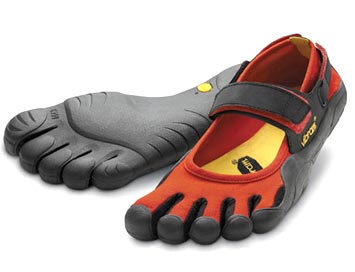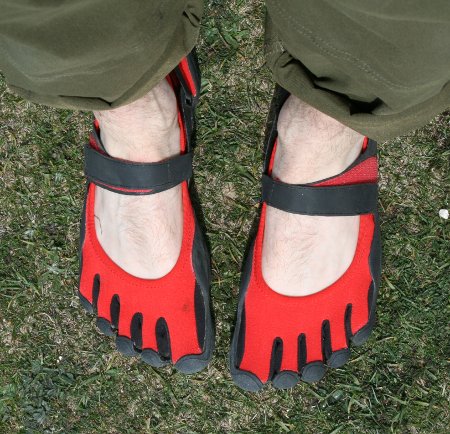After a long period of indecision, I've eventually decided to buy a pair of
Vibram Five Fingers shoes (sprint model). I guess they can be best described as a pair of gloves for the feet.

I've been attracted by them for several reasons, so many that I actually feel like I've been naively caught into excessive consumerism by some clever marketing teams :)
- Novelty factor and the satisfaction to try something singularly different.
- Sensations, following the idea I've developed in "The tortoise and the hare" about seeing every single meter of ground between London and Brighton, I hope to additionally be able to "feel" every meter of ground. It is not clear yet whether I'll be able to run long distances with them or not, but the principle applies to shorter runs too. Gaining extra feeling on the feet will hopefully contributes to this idea in two ways. On a physical level, I hope they will provide an extra source of sensation, just as the Inov8 Flyrock were surprisingly a lot of fun to run with on slightly adverse terrain (sand, mud, snow, ...). On a more psychological level, they might help with the "connection with the Earth" type of feeling.
- Injury prevention: there is increasing evidence that modern, massively cushioned running shoes are not necessarily better than their cheaper counterparts, with studies showing that people running in expensive shoes are more that twice as likely to get injured. Cushioning gives the human body the impression that it can land heavily, which inevitably alters the walking/running style way. Whether this is problematic or not is still up for debate amongst sport scientists. Beside, several studies have shown that induced stress on the bones triggers bone growth, which will later delay osteporosis. Now, where is the limit between beneficial stress and harmful shocks is not clear. But after all, the human body was originally designed to walk and run barefoot.
I guess I can only try them in various conditions and see whether they meet my expectations.
Trial 1: shopping at the local supermarket
The first thing I noticed when I went out was that I could very easily tell apart the different kinds of concrete and asphalt I was walking on, which is rather nice. The second thing is that the impact on the heel and on the metatarsals feels fairly hard compared to using typically cushioned shoes. And the third thing is that you don't walk unnoticed - lots of people literally scrutinised them. Some people say they look silly. That said, millions of people have bought the
Crocs which look ugly even to my underdeveloped sense of fashion. Personally, I think the Five Fingers look rather funny.
Trial 2: commuting walk
I then decided to walk 5km in them to see how they feel on longer distances. Again, the heel contact is rather hard, unless you try to land mid-foot or even on the toes. However, I couldn't sustain that for very long as I not only looked like I was training for a catwalk, but it's also fairly hard to balance on landing. Towards the end, I started to get blisters under my heels, which is fairly unexpected. Furthermore, I took a couple minutes longer than my usual commuting time, which can be impeded on the shorter stride required to reduce the ground reaction force during the initial heel contact. Walking a bit on the grass in Hyde Park felt so much better than the concrete. I guess humans were designed before the roads.
Trial 3: short run in the park
I then went for a 6.3km short run in the park. At first it felt pretty good, as it's much easier to land mid-foot or on the toes while running than walking. Soon, I managed to bounce on my arches, with my heel barely touching the ground, as if my feet were mounted on springs. That led to a great feeling, just like I was moving effortlessly. The concrete felt rather hard, the grass was nice, and the sand (for the horses) was great. Little by little, though, I started to feel the tiredness in my arches, and when I eventually stopped I thought my calves would seize up - they didn't.
The outcome of these preliminary tests is rather positive, but I don't think I will suddenly change completely my habits and drop all my other shoes for this new pair. I will just gradually replace some (short) training sessions or commuting walks. That should help to strengthen some muscles of the lower legs and feet. And that will diversify even more my running and walking habits, which in my opinion is the best way to prevent injuries. Indeed, variety in running session characteristics such as distance, speed and surface reduces the risk of injuries.
Further tests are to come: hill walking, trail running and maybe climbing, open water swimming and canoeing. I guess they might be more suitable for these activities that do not take place on concrete, although it's hard to guess what their grip will be on wet/muddy terrain.
> Tests continue in
part 2 and
part 3.
Ultra thin soles
PS: Note that the brand name "Vibram" has nothing to do with anti-vibration insoles as I've heard sometimes. It's derived from the company founder's name, Vitale Bramani.

